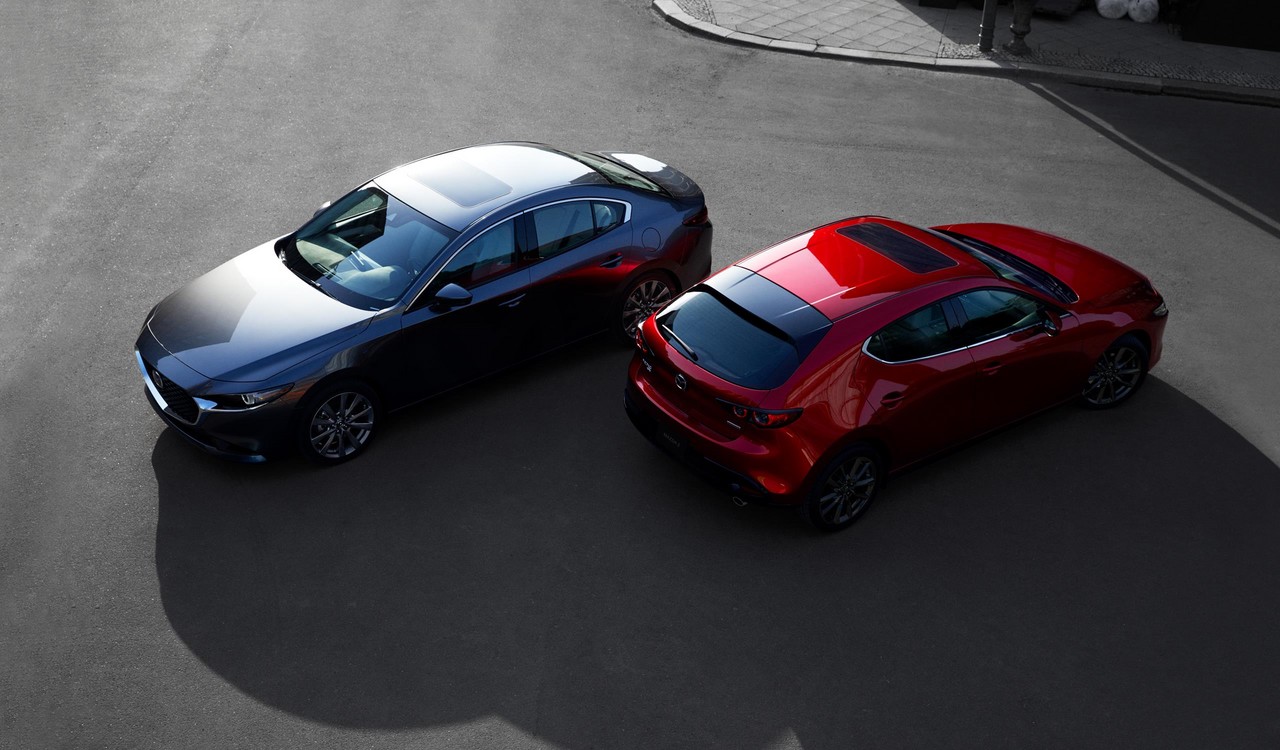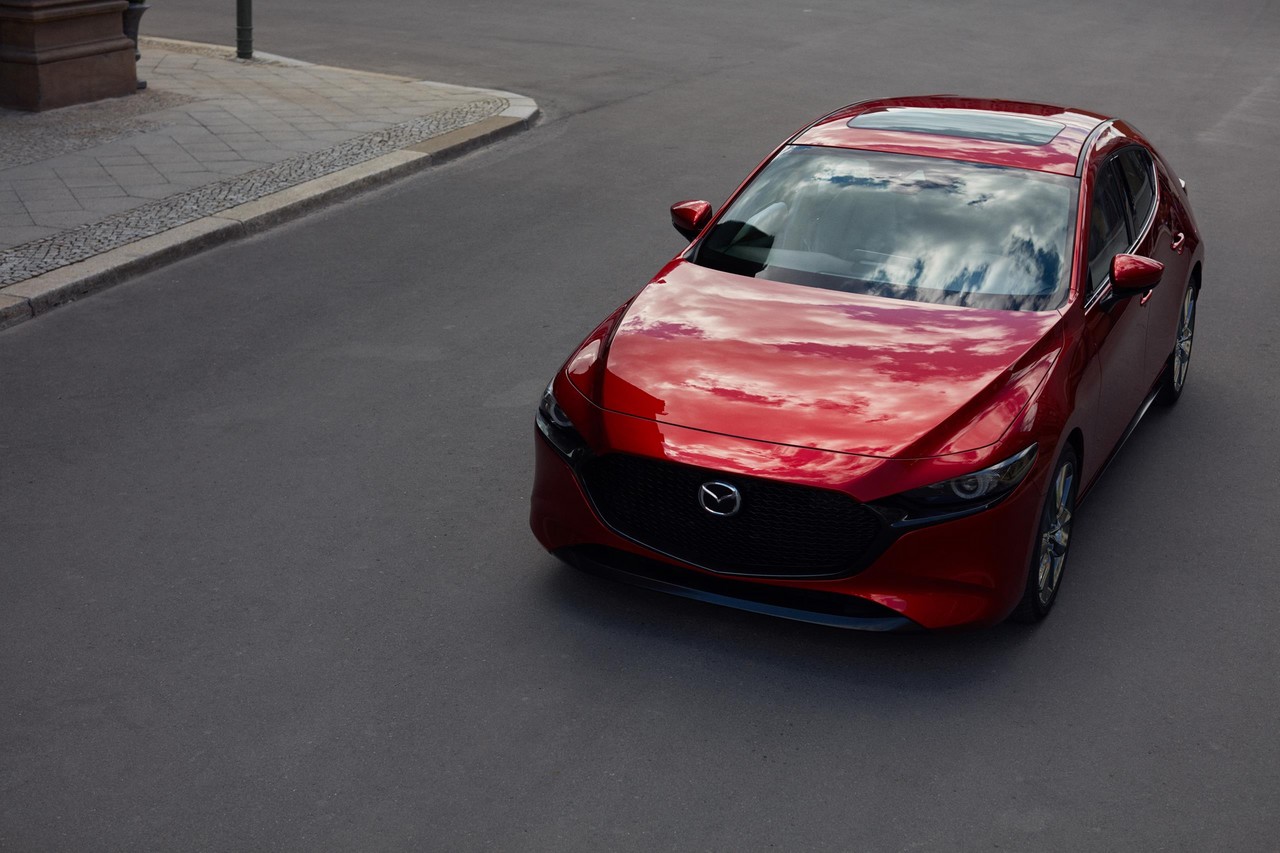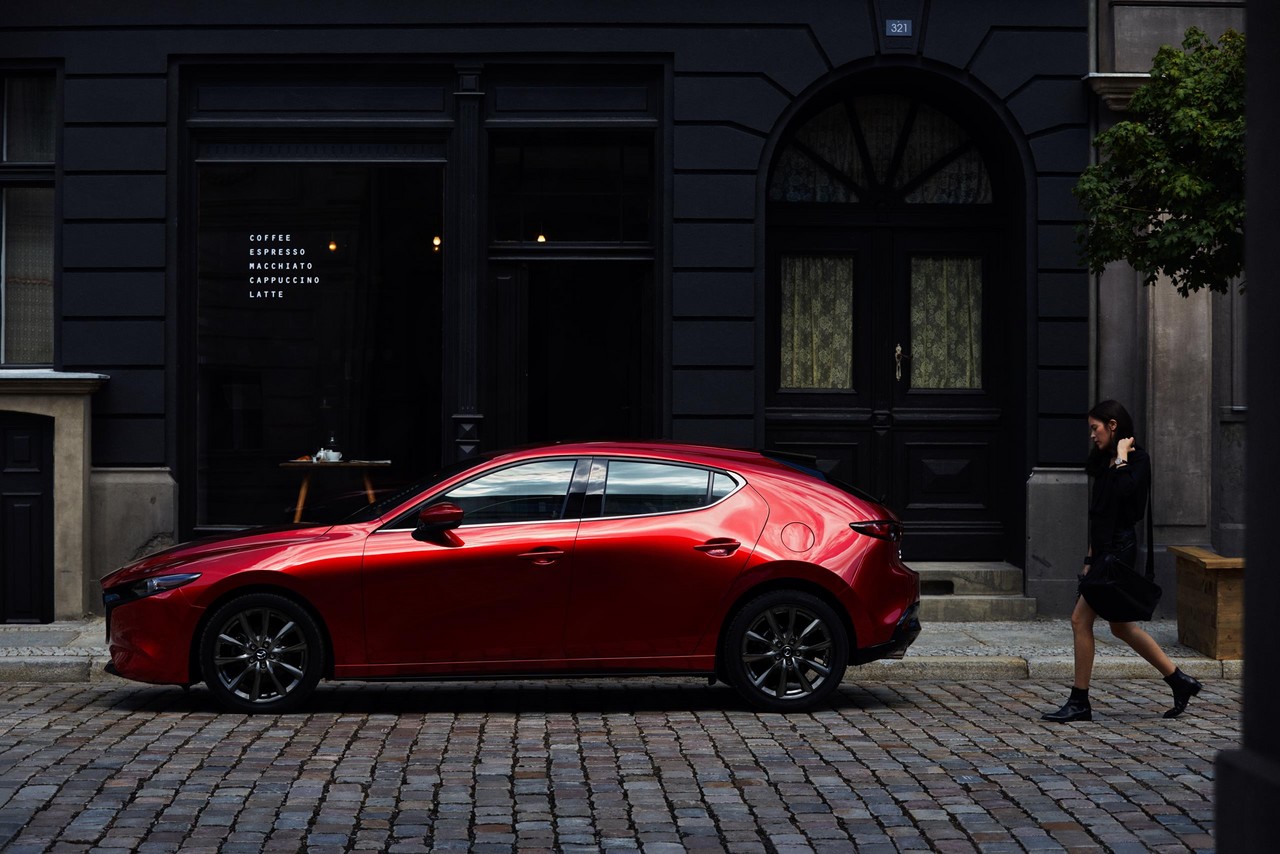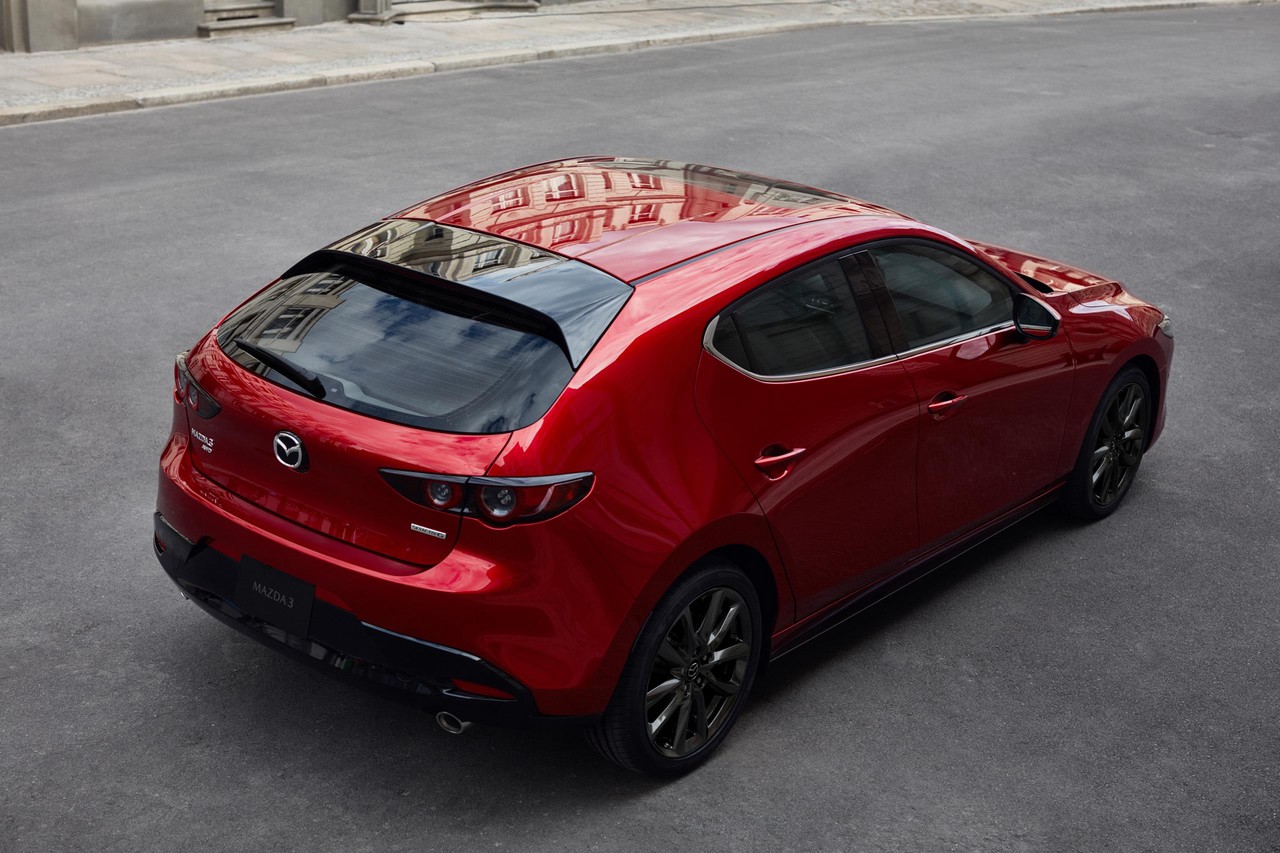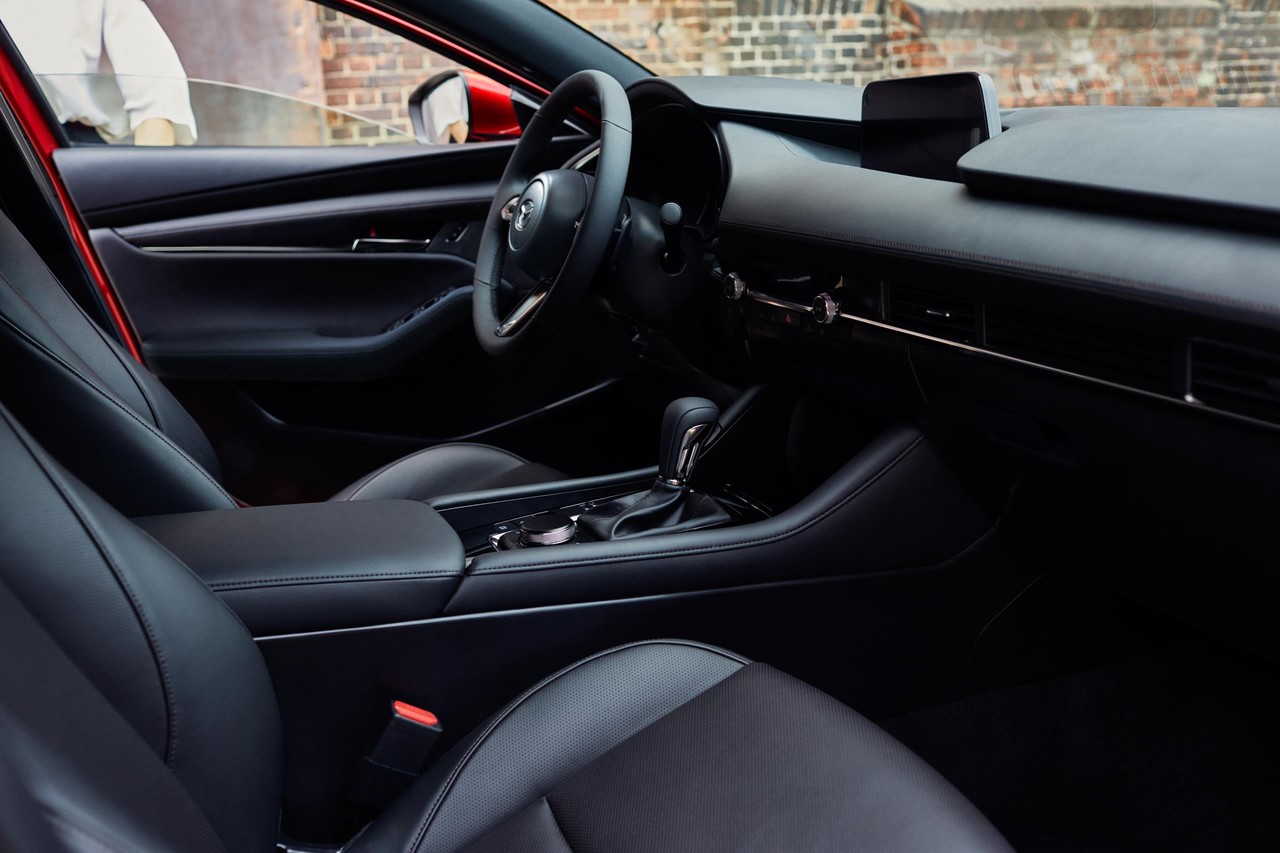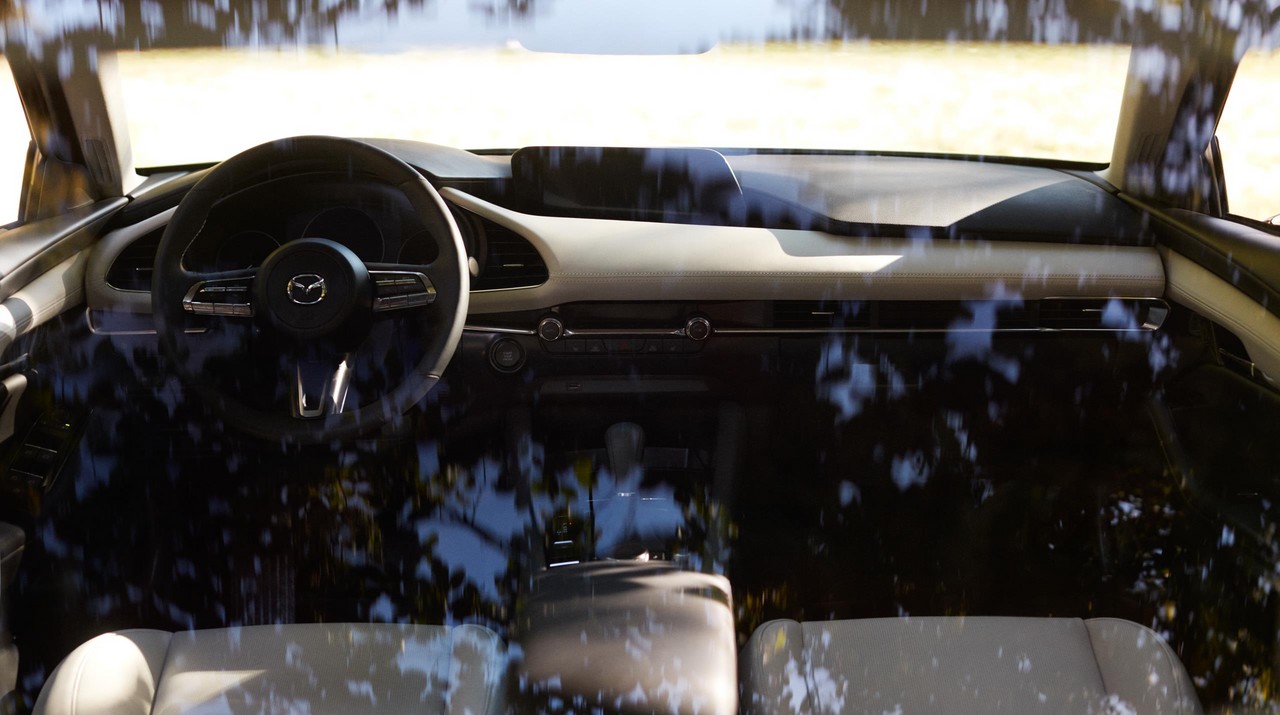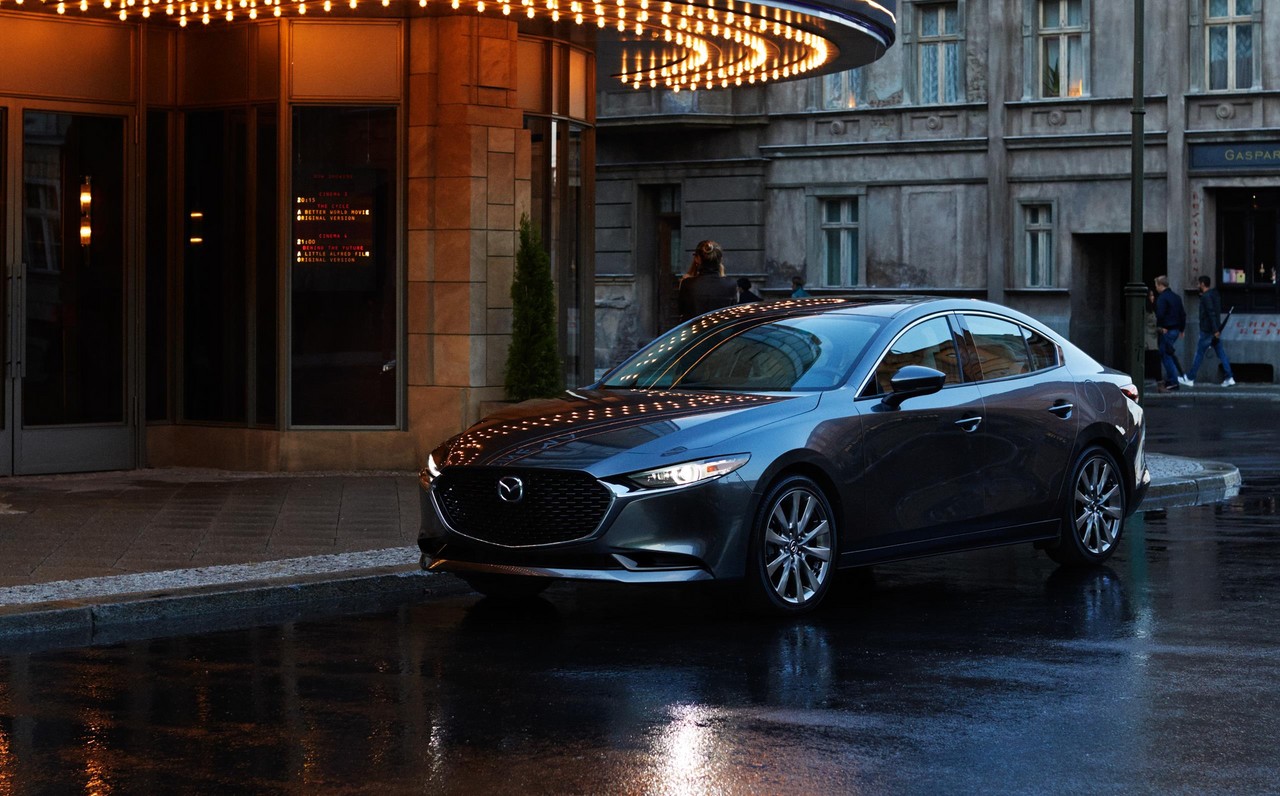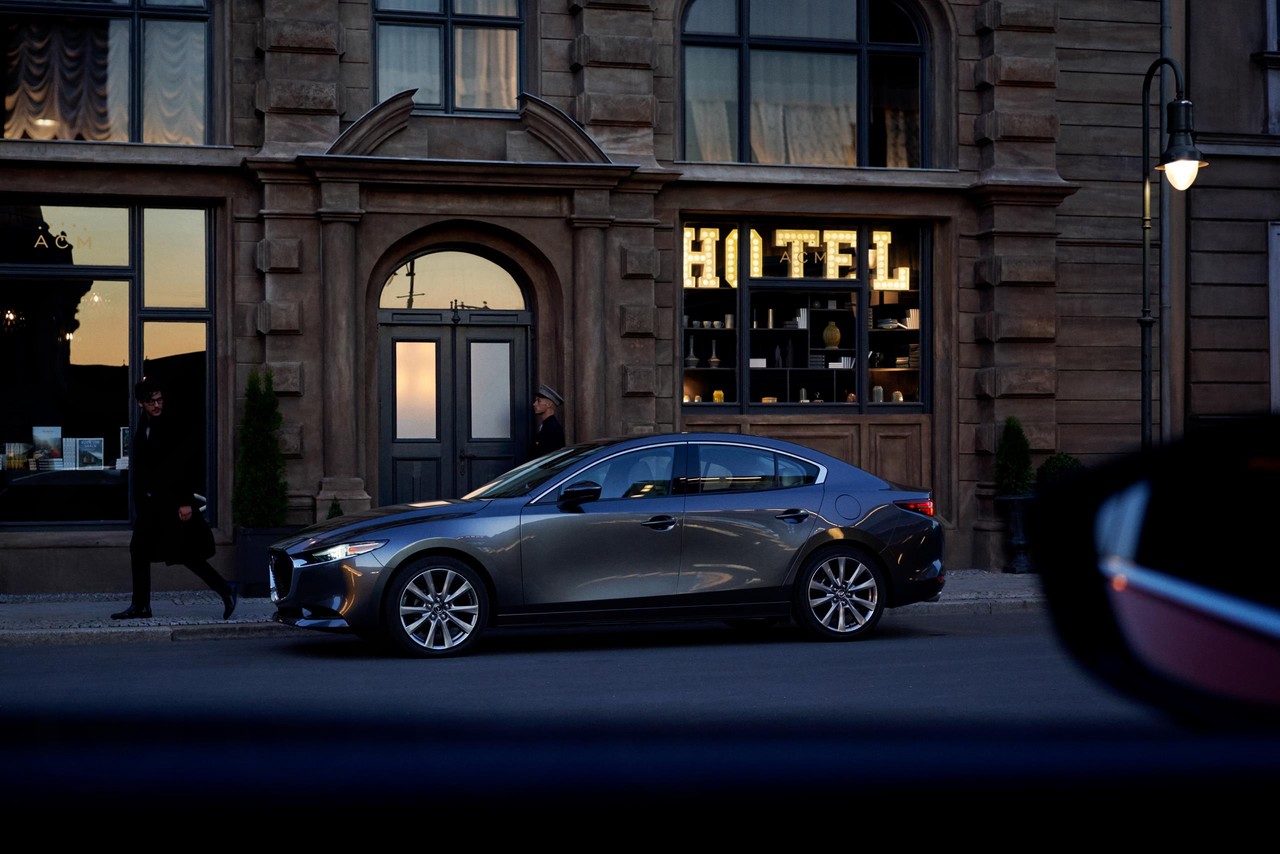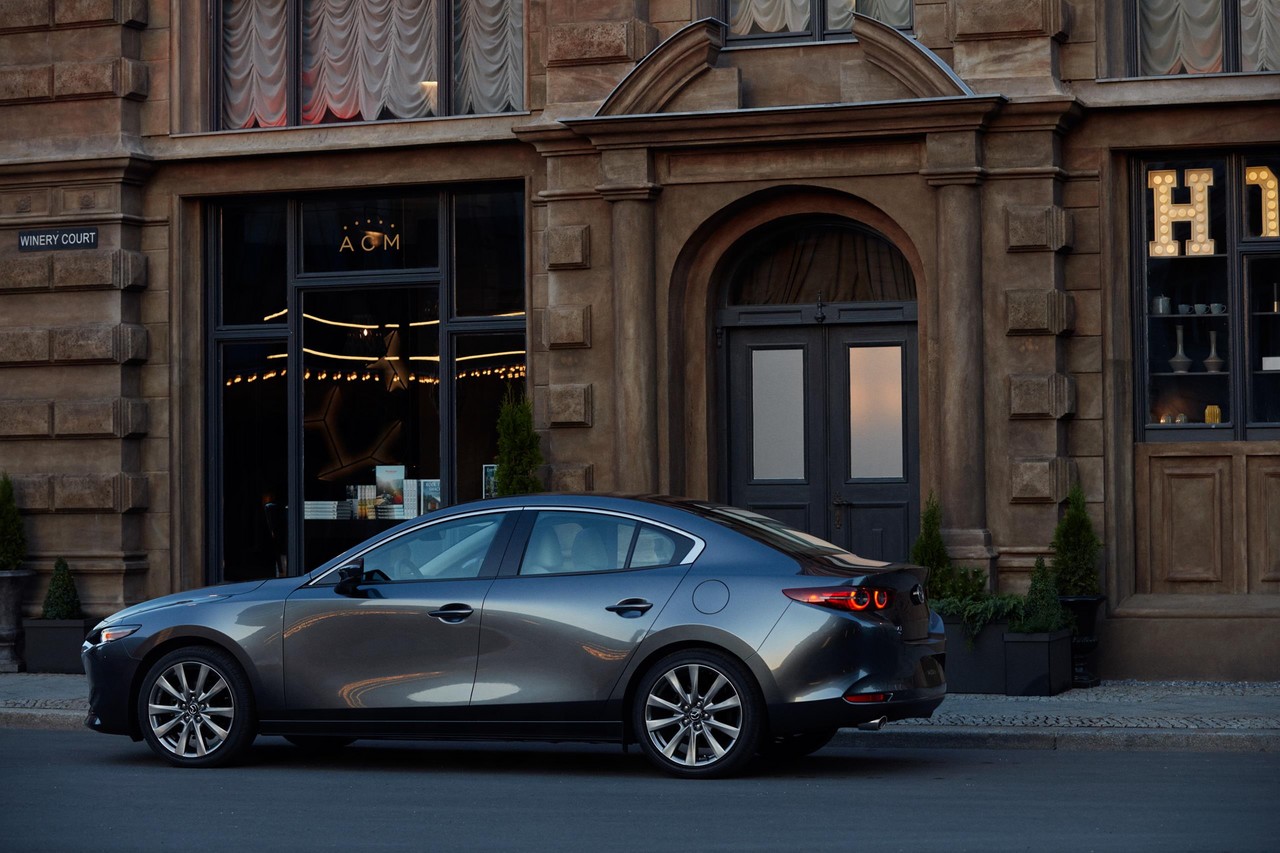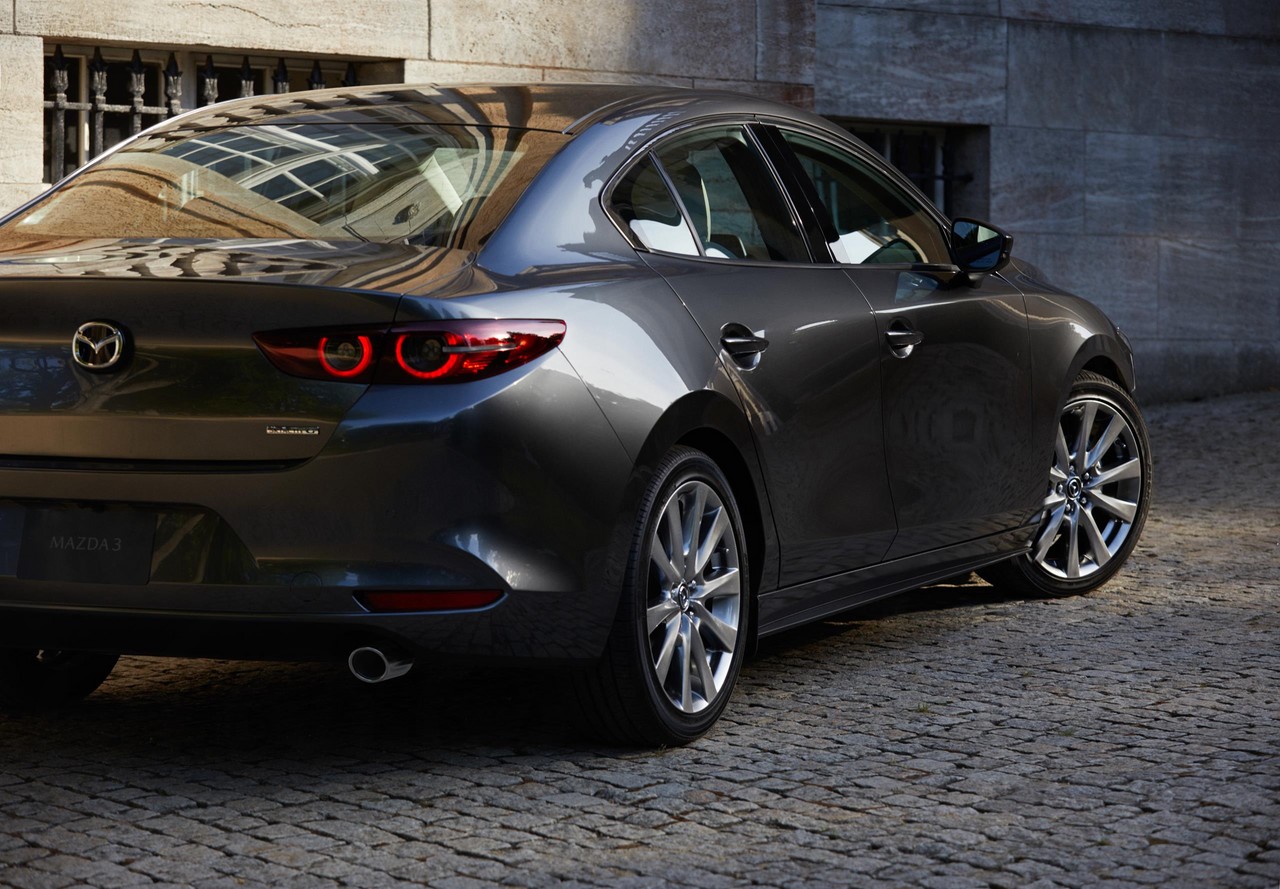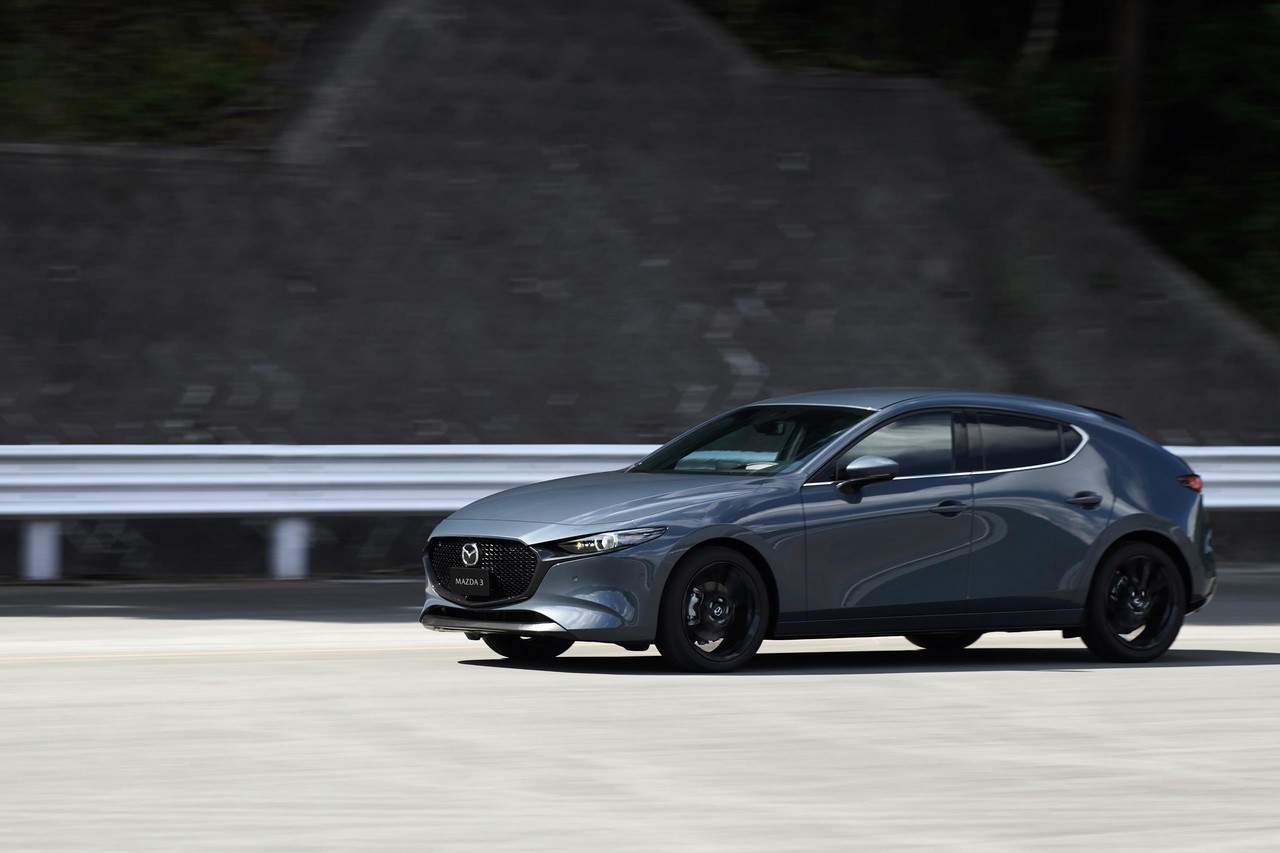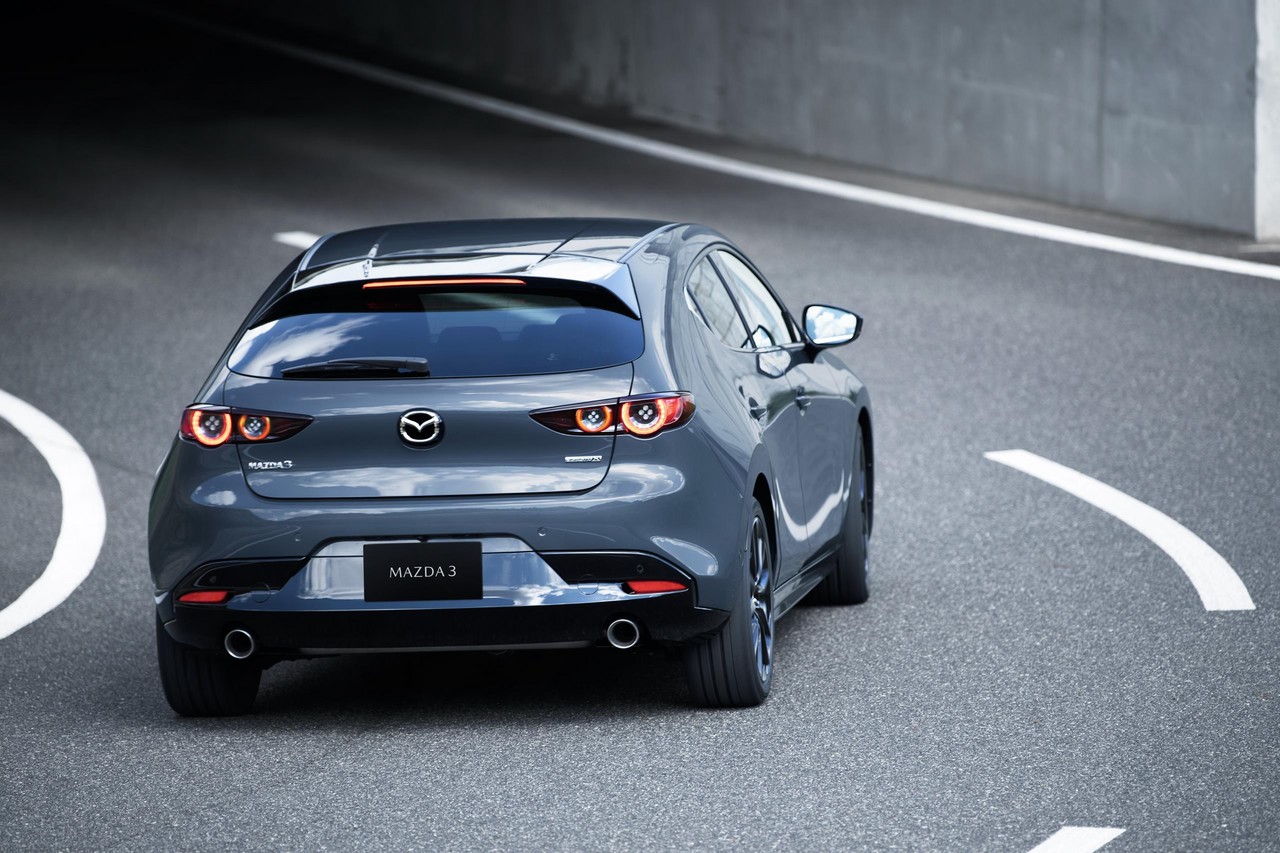
- Active safety technologies fitted as standard
- For passive safety, ‘SkyActiv’ vehicle architecture makes extensive use of high tensile steels
- Impressive ride/handling balance
- Good driving position
- Improved sound insulation
- For hatch, thick C-pillars impair visibility
- Raked roofline reduces rear seat headroom
- Limited rear seat legroom
- Reduced luggage capacity for hatch
- For hatch, poor rear visibility
Overview
Released in Australia in April 2019, the Mazda BP Mazda3 was available in hatchback and sedan bodies. Manufactured in Hofu, Japan, the front-wheel drive Mazda BP Mazda3 was initially powered by 2.0- and 2.5-litre petrol engines (the G20 and G25 variants, respectively) that were mated to six-speed manual or automatic transmissions. Furthermore, the BP Mazda3 range consisted of Pure, Evolve, Touring, GT and Astina editions. Before the end of 2019, the BP Mazda3 will be available with Mazda’s ‘SkyActiv-X’ engine which features ‘spark-controlled compression ignition’ and an ‘M Hybrid’ system.
Both the 2.0- and 2.5-litre SkyActiv-G engines had Mazda’s ‘i-stop’ system which enabled the engine to shut down when the vehicle was stationary to minimise fuel consumption. The 2.5-litre engine, however, also had a cylinder deactivation function which used a mechanism in the hydraulic lash adjusters to shut down cylinders #1 and #4 when the vehicle was operating at steady speeds between 40 km/h and 80 km/h. Because the firing interval was double that compared to when the engine was running on two cylinders, a centrifugal pendulum dampener was fitted to the six-speed automatic transmission’s torque converter to reduce vibrations.
| Variant | Edition | Engine | Trans. | Power | Torque |
|---|---|---|---|---|---|
| G20 | Pure, Evolve, Touring |
2.0-litre PE-VPS petrol I4 | 6sp man., 6sp auto |
114 kW at 6000 rpm | 200 Nm at 4000 rpm |
| G25 | Evolve, GT, Astina |
2.5-litre PY-VPS petrol I4 | 6sp man., 6sp auto |
139 kW at 6000 rpm | 252 Nm at 4000 rpm |
G-Vectoring Control Plus (GVC Plus)
Previously introduced in the Mazda KF CX-5 , the Mazda BP Mazda3 was equipped with Mazda’s G-Vectoring Control Plus (GVC Plus). G-Vectoring Control Plus had two functions:
- As the steering wheel was turned, engine torque was slightly reduced – usually by 0.01 g or less – to generate a small shift in load to the front axle. According to Mazda, this torque reduction improved cornering response by optimising the vertical load on each wheel; and,
- Light braking force was applied to the outer wheels when cornering as the steering wheel returned to the centre position, providing a ‘recovery moment’ to restore the vehicle to straight line running. As a result, the vehicle was more stable after initial emergency avoidance actions and when driving on slippery surfaces.
Body and dimensions
The Mazda BP Mazda3 was underpinned by Mazda’s new ‘Skyactiv-Vehicle Architecture’. For the body,
- The BP Mazda3 was the first passenger vehicle to use 1310 MPa ultra-high-tensile steel for its framework, with that steel used for the bumper beam and B-pillars;
- 1180 MPa steel was used for the side sills;
- The ratio of ultra-high-tensile steel rated 980 MPa or higher increased from 3 per cent to 30 per cent;
- 780 MPa high-tensile steel was used for the door hinges;
- To increase rigidity, new front-to-back connections complemented the vertical and lateral connections of the previous body to form multi-directional ring structures; and,
- New perimeter beam and rear side frames would deform in an accordion-style pattern to absorb energy in the event of a collision.
Compared to the BN Mazda3 hatch , the Mazda BP Mazda3 hatch was the same length (at 4460 mm), width (1795 mm), 15 mm lower (1435 mm) and had a 25 mm longer wheelbase (2725 mm). Relative to the hatch, the Mazda3 BP sedan was 202 mm longer (4662 mm) and 5 mm taller (1445 mm), but had the same width and wheelbase length. While the BP Mazda3 hatch had a luggage capacity of 295 litres (VDA method), boot space for the BP Mazda3 sedan was 444 litres.
To reduce NVH, the Mazda BP Mazda3 had a ‘two-wall’ structure that left space between the body and floor carpets. Furthermore, the number of holes in the carpet was reduced to improve sound insulation and sound-absorbing material was added to the headliner and floor mats to supress high-frequency noise.
Suspension
The Mazda BP Mazda3 had MacPherson strut front suspension and, in a change from the multi-link rear suspension of the BN Mazda3, torsion beam rear suspension. According to Mazda, a spherical shape was adopted for the internal structure of the bushings.
Steering
The Mazda BP Mazda3 had rack-and-pinion steering with electric power assistance; its minimum turning circle was 10.6 (kerb to kerb).
Safety equipment
Standard safety equipment for the Mazda BP Mazda3 included dual front airbags, a driver’s knee airbag, front side airbags, full-length curtain airbags, ABS, electronic brake force distribution, brake assist, electronic stability control, traction control, active front seat head restraints and front seatbelts with pre-tensioners and load limiters. For the front side airbags, each airbag was divided into a front and rear chamber. Using reduced air pressure in the forward chamber and higher pressure in the rear chamber reduced the load taken by the rib cage while holding the body in place.
As standard, the Mazda BP Mazda3 was equipped with the following ‘i-ActiveSense’ safety technologies –
- Smart Brake Support (SBS) with Forward Obstruction Warning (FOW): operating at speeds between 15 km/h and 160 km/h, SBS used a milliwave radar sensor and a forward sensing camera to detect vehicles or obstacles on the road ahead. If a potential collision was assessed, an initial alert would sound (Mazda’s ‘Forward Obstruction Warning’) and the braking system would be pressurised. In its secondary phase, SBS applied the brakes lightly to alert the driver and reduce vehicle speed. If a collision was inevitable, SBS applied maximum braking force. In the event that the driver applied the brakes, maximum braking force would also be applied; and,
- Smart Brake Support – Rear (SBS R): operating at speeds between 2 km/h and 8 km/h, SBS R used ultrasound sensors in the rear bumper to detect obstacles up to two metres behind the vehicle. When an obstacle was detected and a high risk of collision was assessed, the brakes would be applied automatically to avoid or reduce the severity of the collision;
- Mazda Radar Cruise Control (MRCC) with stop & go: operating at speeds from stationary to 145 km/h, MRCC used a milliwave radar to judge the relative speed of and distance to the vehicle ahead. In accordance with the target speed set by the driver, MRCC adjusted vehicle speed to maintain a safe distance to the vehicle ahead. Furthermore, the ‘Stop & Go’ function enabled the vehicle to brake until stationary and, when the traffic ahead started to move, automatically accelerate;
- Lane-keep Assist System (LAS) and Lane Departure Warning (LDW): used a forward-sensing camera to monitor lane markings on the road surface and assist the driver to stay in their lane by providing steering torque assistance and steering wheel vibration alerts. The driver could choose from ‘Early’ or ‘Late’ settings to adjust the level of assistance and the timing of its operation. In the ‘Early’ setting, for example, the system provided continuous steering assistance to keep the vehicle in the centre of its lane;
- Rear Cross Traffic Alert (RCTA): could warn the driver of approaching traffic when reversing from a parking space by sounding an audible alert and illuminating LED icons in the door mirrors;
- Traffic Sign Recognition (TSR): used the forward-facing camera to detect speed limit, ‘No Entry’ and ‘Stop’ signs while driving and displayed them on the Active Driving Display;
- Intelligent Speed Assist (ISA): if the vehicle exceeded the speed limit, the driver was alerted by blinking graphics on the display and an audible alert; and,
- Driver Attention Alert (DAA): operating at speeds above 65 km/h, DAA initially observed driver behaviour – such as steering wheel operation, vehicle speed and lane positioning – for 20 minutes to establish a benchmark. The DAA system then monitored driver behaviour for signs of fatigue and recommended rest breaks if detected. Alerts would also be issued if the driver had been driving continuously for more than two hours.
Beyond this, the Mazda BP Mazda3 G25 Astina was further equipped with –
- Smart Brake Support – Rear Crossing (SBS-RC): working in conjunction with the Rear Cross Traffic Alert system, SBS RC would apply the brakes if the driver attempted to reverse when there was crossing traffic approaching from the rear;
- Front Cross Traffic Alert (FCTA): operated at speeds up to 10 km/h and used front side radars to detect other vehicles approaching from blind spots at the front right or left of the vehicle. If detected, a warning tone would sound to alert the driver to their presence;
- Cruising & Traffic Support (CTS): reduced driver fatigue by assisting with accelerator, brake pedal and steering operations when stuck in traffic jams; and,
- A Driver Monitoring system: used an infra-red camera and infra-red LED to observe driver behaviour. The system monitored the driver’s line of sight and eye movement, how open the driver’s eyelids were, blinking frequency and the angle of the mouth and face to measure drowsiness or fatigue. If the system determined that the situation had become dangerous, it would sounds an alert to make the driver aware and worked in conjunction with the Smart Brake Support (SBS) system to shorten the time required for the brake warning to sound.
These technologies – as well as front parking sensors and a 360 degree View Monitor – were available as a $1500 extra-cost option for other Mazda3 editions as part of a ‘Vision Technology’ package.
Euro NCAP testing: 2019 Mazda BP Mazda3
In Euro NCAP testing , the Mazda BP Mazda3 hatchback received a five star safety rating which included a 98 per cent adult occupant protection rating and an 87 per cent child occupant protection rating. In the frontal offset test, occupant protection was generally rated as good, though protection of the driver’s lower legs was rated as adequate (i.e. a slight risk of serious injury). Furthermore, maximum points were awarded in the side impact and pole tests.
Brakes
The Mazda BP Mazda3 had 295 mm by 25 mm ventilated front brake discs and 265 mm by 9 mm solid rear discs.
Features: Mazda BP Mazda3 Pure
The standard ‘Mazda Connect’ infotainment system for the Mazda BP Mazda3 consisted of an eight speaker audio system, digital radio tuner (DAB+), an 8.8-inch touchscreen, satellite navigation, Bluetooth mobile phone connectivity and audio streaming, Apple CarPlay and Android Auto smartphone integration, and a USB input.
Beyond this, standard features for the Mazda BP Mazda3 G20 Pure included 6.5J x 16-inch alloy wheels with 205/60 R16 92V tyres, air conditioning, black cloth seat trim, LED headlamps with High Beam Control, LED daytime running lamps, a reverse camera, rear parking sensors, a head-up display (Mazda’s ‘Active Driving Display’), 60/40 split-fold rear seats, remote central locking, power adjustable mirrors with auto-folding function, power windows, tilt and telescopic steering wheel adjustment, push-button start, a seven-inch TFT LCD multi-information display, vanity mirrors, tyre pressure monitoring, an electric parking brake, a trip computer and an immobiliser.
Features: Mazda BP Mazda3 Evolve
Compared to the Mazda3 G20 Pure, the Mazda3 G20 Evolve was further equipped with 7.0J x 18-inch alloy wheels with 215/45 R18 89W tyres, dual-zone climate control air conditioning, a leather-wrapped steering wheel and gearshift knob, an auto-dimming rear-view mirror and rear seat fold-down armrest. Furthermore, Mazda3 Evolve editions with automatic transmissions are fitted with steering wheel gearshift paddles, while the G25 was also equipped with a ten-way power adjustable driver’s seat and a proximity key.
Features: Mazda BP Mazda3 Touring
Relative to the Mazda3 G20 Evolve, the Mazda3 G20 Touring added black leather seat trim, a ten-way power adjustable driver’s seat, driver’s seat and door mirror memory settings, proximity key, an auto-dimming driver’s side door mirror and illuminated vanity mirrors.
Features: Mazda BP Mazda3 G25 GT
Compared to the Mazda3 G25 Evolve, the Mazda3 G25 GT was further equipped with a Bose sound system with twelve speakers, black leather seat trim, heated front seats, a heated steering wheel, heated door mirrors, an auto-dimming driver’s side door mirror and illuminated vanity mirrors.
Features: Mazda BP Mazda3 G25 Astina
Against the Mazda3 G25 GT, the range-topping Mazda3 G25 Astina was distinguished by its front parking sensors, ‘360 degree View Monitor’ camera system and a power sliding glass sunroof. The Mazda3 G25 Astina also had Adaptive LED Headlights (ALH) that consisted of an array of 12-block LEDs for the low and glare-free high beams, and an additional array of eight-block LEDs for the high beams. The LED headlights provided illumination over a range of approximately 200 metres and illumination from the high beams could be distributed in three patterns depending on vehicle speed, while headlight direction could be adjusted through six steps according to steering angle.
As an option, the Mazda3 G25 Astina could be specified with ‘Pure’ white leather seat trim for the Mazda3 sedan or Burgundy leather seat trim for the hatch.
Brochures
